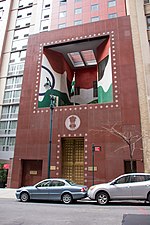Permanent Mission of Bangladesh to the United Nations
1972 establishments in New York CityBangladesh and the United NationsBangladesh–United States relationsDiplomatic missions in ManhattanDiplomatic missions of Bangladesh ... and 2 more
Missions to the United NationsPermanent Representatives of Bangladesh to the United Nations
Permanent Mission of Bangladesh to the United Nations is the diplomatic mission of Bangladesh to the United Nation in New York City. It is under the Ministry of Foreign Affairs.
Excerpt from the Wikipedia article Permanent Mission of Bangladesh to the United Nations (License: CC BY-SA 3.0, Authors).Permanent Mission of Bangladesh to the United Nations
2nd Avenue, New York Manhattan
Geographical coordinates (GPS) Address Nearby Places Show on map
Geographical coordinates (GPS)
| Latitude | Longitude |
|---|---|
| N 40.750977 ° | E -73.97138 ° |
Address
2nd Avenue 821
10017 New York, Manhattan
New York, United States
Open on Google Maps





